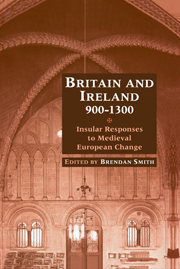Book contents
- Frontmatter
- Contents
- Contributors
- Preface
- List of abbreviations
- 1 The effect of Scandinavian raiders on the English and Irish churches: a preliminary reassessment
- 2 The changing economy of the Irish Sea province
- 3 Cults of Irish, Scottish and Welsh saints in twelfth-century England
- 4 Sea-divided Gaels? Constructing relationships between Irish and Scots c. 800–1169
- 5 The 1169 invasion as a turning-point in Irish-Welsh relations
- 6 Killing and mutilating political enemies in the British Isles from the late twelfth to the early fourteenth century: a comparative study
- 7 Anglo-French acculturation and the Irish element in Scottish identity
- 8 John de Courcy, the first Ulster plantation and Irish church men
- 9 Coming in from the margins: the descendants of Somerled and cultural accommodation in the Hebrides, 1164–1317
- 10 Nobility and identity in medieval Britain and Ireland: The de Vescy family, c. 1120–1314
- Bibliography
- Index
2 - The changing economy of the Irish Sea province
Published online by Cambridge University Press: 30 July 2009
- Frontmatter
- Contents
- Contributors
- Preface
- List of abbreviations
- 1 The effect of Scandinavian raiders on the English and Irish churches: a preliminary reassessment
- 2 The changing economy of the Irish Sea province
- 3 Cults of Irish, Scottish and Welsh saints in twelfth-century England
- 4 Sea-divided Gaels? Constructing relationships between Irish and Scots c. 800–1169
- 5 The 1169 invasion as a turning-point in Irish-Welsh relations
- 6 Killing and mutilating political enemies in the British Isles from the late twelfth to the early fourteenth century: a comparative study
- 7 Anglo-French acculturation and the Irish element in Scottish identity
- 8 John de Courcy, the first Ulster plantation and Irish church men
- 9 Coming in from the margins: the descendants of Somerled and cultural accommodation in the Hebrides, 1164–1317
- 10 Nobility and identity in medieval Britain and Ireland: The de Vescy family, c. 1120–1314
- Bibliography
- Index
Summary
The beginning of a survey about the trade and economy of the Irish Sea province should note that there has been much general acknowledgement of its importance, but little specific study of it. The wealth and economic vitality of the Irish Sea are frequently mentioned in discussions of insular history during the high Middle Ages, but there has been little scholarly study of its commercial history as a whole. This neglect is not unexpected, especially since the materials customary for economic history begin to appear only late and sparsely in the period. Irish Sea commerce, moreover, is intertwined with other considerations such as the spread of saintly cults – the veneration of St Wulfstan of Worcester at Dublin was due as much to maritime contacts with southeast England as to his patronage of clergy from the town – or the composition of literature; the Irish locations found in the tales of the Mabinogion suggest the avenues of Hiberno-Welsh trade. The following discussion does not propose to remedy the defect, for a comprehensive study would be a book in itself. Merely a few comments will be made concerning some interesting aspects of trade and economy in the Irish Sea province from the tenth to thirteenth centuries, a period of change throughout Europe.
- Type
- Chapter
- Information
- Britain and Ireland, 900–1300Insular Responses to Medieval European Change, pp. 39 - 66Publisher: Cambridge University PressPrint publication year: 1999
- 4
- Cited by

